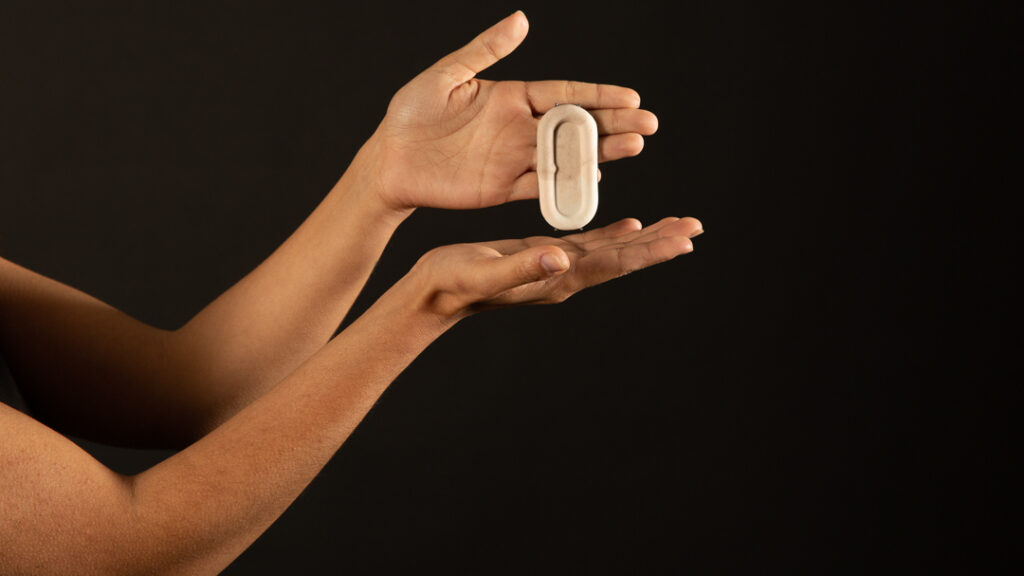
Joani Groenewald. [Un]connected #12. Sculpture. 2023. Resin, found shade netting. 84 x 40 x 8 cm. Series of 20. Photographer: Ashely Walters
Joani Groenewald presents jewellery in a landscape setting that reflects the fragile connections between people and the environment.
In a country that has historically been marked by territorial divisions and questions of land ownership, I use my practice as a jewellery artist to explore complex issues of connection, segregation, and identity in the South African context. I draw from my experiences in the Groot Drakenstein area in the Western Cape where I currently reside, as well as the farm where I lived as a child in the Eastern Cape, to investigate how art objects can act as meaningful markers of both place and identity and reveal the intricate connections between humans and their natural environment.
My practice is situated at the intersection of art jewellery, translation studies, and critical discussions about land. I investigate how jewellery and sculpture can serve as mediums for translating and embodying the South African landscape. Central to my research is the idea of translation—not just as a linguistic process but as a broader exploration of how material and form can convey meaning, memory, and emotional connection.
One of my recent series, [Un]connected, delves into themes of territorialisation, land ownership, and the politics of segregation. In this series, I use chains—symbols of restriction, division, and control—to critique the systems that segregate land and people. At the same time, I reflect on the paradox of connectivity that these very systems create.
Chains are often associated with restricting access, keeping certain areas out of reach for some while making them available to others. In this sense, the chain becomes a symbol of unequal power relations tied to the politics of land, segregation, and ownership. In jewellery, chains also serve to attach jewels and gems to the body, which implies a different kind of ownership and personal attachment.
Yet the chain itself is an object that relies on its interconnectedness to function. A single chain link on its own cannot attach a pendant or a charm to a human body, nor can a single chain link cordon off a territory. The chain relies on the sum of its parts for its collective strength. The chain, then, is ultimately ironic as it relies on interconnectedness to operate as a mechanism of segregation, an instrument for enforcing ownership and power, and a division between people.
- Joani Groenewald, [Un]connected #1, Sculpture, 2023/2024, Porcelain, natural clay, copper, thatching twine, 180 x 20 x 1.3 cm, Series of 20, Photographer: Ashely Walters (Photograph taken in the location where the clay was collected)
- Joani Groenewald. [Un]connected #13. 2023/2024. Concrete, natural sand. 80 x 40 x 10cm. Series of 20. Photographer: Ashely Walters
- Joani Groenewald. [Un]connected #7. Brooch. 2023. Porcelain, natural clay, steel, sterling silver. 6 x 4 x 1 cm. Series of 20. Photo by the artist.
- Joani Groenewald. [Un]connected #17. Necklace. 2024. Resin, Stone, Oxidized Sterling Silver, and Leather Cord. 12.5 x 4 x 1.4 cm. Cord Length: 39cm. Series of 20. Photo by the artist.
- Joani Groenewald. [Un]connected #4. Brooch. 2023. Glazed porcelain, natural clay, steel, sterling silver. 7.5 x 4 x 1 cm. Series of 20. Photo by the artist.
In the [Un]connected series, I reimagine chains—traditionally used to delineate boundaries or signify ownership—in delicate, fragile forms that highlight their inherent contradictions. A single chain link, disconnected from its collective structure, loses its power to divide or connect. Yet, when linked together, the chain becomes an instrument of both connection and disconnection—an exploration of the contradictory forces at play in questions of land and identity.
In [Un]connected #1, I created a chainmail structure from porcelain and clay, incorporating local soil from the Groot Drakenstein. The ceramic chain links are deliberately fragile, designed to break under pressure. This fragility suggests that the very systems meant to divide and restrict are themselves delicate and tenuous. By incorporating local materials, I connect the work to the land and my own experiences of place and belonging. The fragility of the chainmail speaks to the vulnerability of human relationships—between people, between communities, and between people and the environment.
Through this series of work, I encourage an immersive, sensory approach to understanding land and identity. The act of making becomes a form of translation—an embodied, active process that challenges traditional notions of ownership, possession, and separation. In embracing fragility and interconnectedness, I offer commentary on the need for care, empathy, and a reimagined sense of belonging in the context of contemporary South African society.
In a country where the boundaries between people, land, and identity are often drawn in rigid, divisive lines, my jewellery offers a tactile, thoughtful exploration of what it means to connect—and perhaps, in the process, encourages contemplation on the very structures that are designed to segregate.
Follow @joanigroenewald1







Comments
n4tpx2